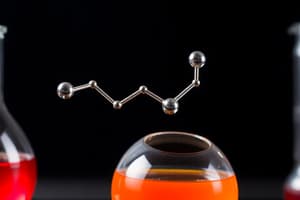Podcast
Questions and Answers
Which type of reaction allows amines to replace halogen atoms in alkyl halides?
Which type of reaction allows amines to replace halogen atoms in alkyl halides?
- Acid-base reactions
- Reduction reactions
- Nucleophilic substitution reactions (correct)
- Nucleophilic addition reactions
What type of bond is formed between the nitrogen and carbon atoms in the reaction of amines with aldehydes and ketones?
What type of bond is formed between the nitrogen and carbon atoms in the reaction of amines with aldehydes and ketones?
- Triple bond
- Single bond
- Ionic bond
- Double bond (correct)
Which method involves the hydrogenation of nitro compounds to produce primary amines?
Which method involves the hydrogenation of nitro compounds to produce primary amines?
- Reaction of ammonia with alkyl halides or alkenes
- Acid-base reactions
- Reduction of nitro compounds (correct)
- Nucleophilic substitution reactions
In which type of reaction do amines act as weak bases by accepting protons from acids?
In which type of reaction do amines act as weak bases by accepting protons from acids?
What do amines form when they react with ammonia and alkyl halides or alkenes?
What do amines form when they react with ammonia and alkyl halides or alkenes?
Which reaction pathway involves the formation of secondary or tertiary amines?
Which reaction pathway involves the formation of secondary or tertiary amines?
Which application of amines involves their use as intermediates in the synthesis of dyes and fragrances?
Which application of amines involves their use as intermediates in the synthesis of dyes and fragrances?
Which property of amines is attributed to the lone pair of electrons on the nitrogen atom?
Which property of amines is attributed to the lone pair of electrons on the nitrogen atom?
What classification of amines has three alkyl or aryl groups bonded to the nitrogen atom?
What classification of amines has three alkyl or aryl groups bonded to the nitrogen atom?
The Strecker synthesis involves the reaction of which three components to form α-aminonitriles?
The Strecker synthesis involves the reaction of which three components to form α-aminonitriles?
Study Notes
Understanding Amines: Chemistry's Versatile Compounds
Amines, compounds containing nitrogen atoms bonded to hydrogen and other atoms or groups, are an essential class of organic compounds with a wide range of applications. They exhibit unique properties, diverse reactions, and numerous synthesis pathways, making them an exciting area of study in chemistry.
Reactions of Amines
Amines can participate in various chemical reactions, each revealing their distinct properties.
- Nucleophilic substitution reactions: Amines can replace halogen atoms in alkyl halides, forming substituted amines through the SN2 mechanism.
- Nucleophilic addition reactions: Amines can add to aldehydes and ketones, forming imines through the formation of a double bond between the nitrogen and carbon atoms.
- Reduction reactions: Amines can be reduced to ammonia, hydroxylamine, or primary amines via specific conditions.
- Acid-base reactions: Amines can act as weak bases, accepting protons from acids.
Synthesis of Amines
Amines can be synthesized through various methods, several of which are outlined below.
- Reduction of nitro compounds: Hydrogenation of nitro compounds can lead to the formation of primary amines.
- Reaction of ammonia with alkyl halides or alkenes: By reacting ammonia with alkyl halides or alkenes, primary or secondary amines can be formed.
- Strecker synthesis: The reaction of an aldehyde, hydrogen cyanide, and an ammonium salt can lead to the formation of α-aminonitriles, which can be converted into primary amines.
- Reductive amination: The reaction of an aldehyde or ketone with an amine in the presence of a reducing agent can lead to the formation of secondary or tertiary amines.
Applications of Amines
Amines have a wide range of applications due to their unique properties.
- Drugs: Amines can have therapeutic effects, such as acetaminophen and many antidepressants.
- Catalysts: Amines can act as catalysts in various chemical reactions, such as the hydrogenation of alkenes and the Claisen rearrangement.
- Intermediates: Amines can be used as intermediates in the synthesis of other organic compounds, such as dyes, fragrances, and agricultural chemicals.
- Polymer additives: Amines can be used as polymer additives to enhance their properties, such as flame retardancy and antistatic properties.
Properties of Amines
Amines exhibit unique properties due to their nitrogen atom and its ability to form covalent bonds.
- Basicity: Amines are basic due to the lone pair of electrons on the nitrogen atom, which can accept protons from acids.
- Solvency: Some amines, such as triethylamine, are excellent solvents for organic compounds.
- Volatility: Amines have a wide range of volatility, depending on their size and the presence of other functional groups.
Classification of Amines
Amines can be classified according to the number of alkyl or aryl groups attached to the nitrogen atom.
- Primary amines (1° amines) have one alkyl or aryl group bonded to the nitrogen atom.
- Secondary amines (2° amines) have two alkyl or aryl groups bonded to the nitrogen atom.
- Tertiary amines (3° amines) have three alkyl or aryl groups bonded to the nitrogen atom.
Understanding the chemistry of amines offers valuable insights into the field of organic chemistry and provides the foundation for further research and application in various areas, including pharmaceuticals, materials science, and catalysis.
Studying That Suits You
Use AI to generate personalized quizzes and flashcards to suit your learning preferences.
Description
Explore the versatile world of amines in organic chemistry, from their unique properties and diverse reactions to their wide range of applications in pharmaceuticals, catalysis, and more. Learn about amine synthesis methods and classification based on alkyl or aryl group attachments to the nitrogen atom.




